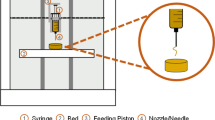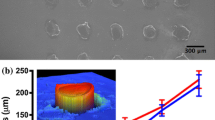Abstract
We designed a resorcinol-formaldehyde (RF) sol–gel ink for direct ink writing of the microlattices. To improve the formability, the fresh microlattices were strengthened by surface catalysis with HCl atmosphere. After supercritical drying and carbonization, the sample’s specific surface area was 631 m2/g and the average pore size was 3.81 nm. Both RF aerogel and carbonized RF aerogel samples had millimeter-scale pore, micron-scale pore, and nanoscale skeleton. The pore and skeleton could provide high surface area and diffusion channels, which were beneficial to the adsorption performances. The carbonized RF aerogel sample fully adsorbed Dulbecco’s modified eagle medium in 250 min, which exhibited a good capacity of quick adsorption and indicated the potential application for cell supports.








Similar content being viewed by others
References
C. Zhu, T.Y-J. Han, E.B. Duoss, A.M. Golobic, J.D. Kuntz, C.M. Spadaccini, and M.A. Worsely: Highly compressible 3D periodic graphene aerogel microlattices. Nat. Commun. 6, 6962 (2014).
B.G. Compton and J.A. Lewis: 3D printing of lightweight cellular composites. Adv. Mater. 26, 5930 (2014).
R.A. Bary, III, R.F. Shephers, J.N. Hanson, R.G. Nuzzo, P. Wiltzius, and J.A. Lewis: Direct write assembly of 3D hydrogel scaffolds for guided cell growth. Adv. Mater., 21, 2407 (2010).
W. Wu, A. DeConinck, and J.A. Lewis: Omnidirectional printing of 3D microvascular networks. Adv. Mater. 23, 178 (2011).
J.P. Lewicki, J.N. Rodriguez, C. Zhu, M.A. Worsley, A.S. Wu, Y. Kanarska, J.D. Hprn, E.B. Duoss, J.M. Ortega, W. Elmer, R. Hensleigh, R.A. Fellini, and M.J. King: 3D-printing of meso-structurally ordered carbon fiber/polymer composites with unprecedented orthotropic physical properties. Sci. Rep. 7, 43401 (2017).
J.N.H. Shepherd, S.T. Parker, R.F. Shepherd, M.U. Gillette, J.A. Lewis, and R.G. Nuzzo: 3D microperiodic hydrogel caffolds for robust neuronal cultures. Adv. Funct. Mater. 21, 47 (2011).
M. Gratson and J.A. Lewis: Phase behavior and rheological properties of polyelectrolyte inks for direct-write assembly. Langmuir 21, 457 (2005).
E. Vorndran, U. Klammert, A. Ewald, J.E. Barralet, and U. Gbureck: Simultaneous immobilization of bioactives during 3D powder printing of bioceramic drug release matrices. Adv. Funct. Mater. 20, 1585 (2010).
J.E. Smay, G.M. Gratson, R.F. Shepherd, J. Cesarano, and J.A. Lewis: Directed colloidal assembly of 3D periodic structures. Adv. Mater. 14, 1279 (2002).
M. Sweeney, L.L. Campbell, J. Hanson, M.L. Pantoyo, and G.F. Christopher: Characterizing the feasibility of processing wet granular materials to improve rheology for 3D printing. J. Mater. Sci. 4, 1 (2017).
J.M. McCracken, A. Badea, M.E. Kandel, A.S. Gladman, D.J. Wetzel, G. Popescu, J.A. Lewis, and R.G. Nuzzo: Programming mechanical and physicochemical properties of 3D hydrogel cellular microcultures via direct ink writing. Adv. Healthcare Mater. 5, 1025 (2016).
D. Therriault, R. Shepherd, S. White, and J.A. Lewis: Fugitive inks for direct-write assembly of three-dimensional microvascular networks. Adv. Mater. 17, 395 (2005).
H. Zhang, A. Ramm, S. Lim, W. Xie, B.Y. Ahn, W. Xu, A. Mahajan, W.J. Suszynski, C. Kim, J.A. Lewis, C.D. Frisble, and L.F. Francis: Wettability contrast gravure printing. Adv. Mater. 27, 7420 (2015).
R. Melcher, N. Travitzky, C. Zollfrank, and P. Greil: 3D printing of Al2O3/Cu–O interpenetrating phase composite. J. Mater. Sci. 46, 1203 (2011).
S. Walker and A. Lewis: Reactive silver inks for patterning high-conductivity features at mild temperatures. J. Am. Chem. Soc. 134, 1419 (2012).
C.H.J. Kim, D. Zhao, G. Lee, and J. Liu: Strong, machinable carbon aerogels for high performance supercapacitors. Adv. Funct. Mater. 26, 4976 (2016).
X. Wu, D. Du, R. Fu, and W. Zeng: Preparation of carbon aerogels with different pore structures and their fixed bed adsorption properties for dye removal. Dyes Pigments 95, 689 (2012).
C. Zhu, T. Liu, F. Qian, T.Y. Han, E.B. Duoss, J.D. Kuntz, C.M. Spadaccini, M.A. Worsley, and Y. Li: Supercapacitors based on three-dimensional hierarchical graphene aerogels with periodic macropores. Nano Lett. 16, 3448 (2016).
J.N. Rodriguez, C. Zhu, E.B. Duoss, T.S. Wilson, C.M. Spadaccini, and J.P. Lewicki: Shape-morphing composites with designed micro-architectures. Sci. Rep. 6, 27933 (2016).
A.E. Jakus, E.B. Secor, A.L. Rutz, S.W. Jordan, M.C. Hersam, and R.N. Shah: Three-dimensional printing of high-content graphene scaffolds for electronic and biomedical applications. ACS Nano 9, 4636 (2015).
S. Liao: On the analytic solution of magnetohydrodynamic flows of non-Newtonian fluids over a stretching sheet. J. Fluid Mech. 488, 189 (2003).
Y. Wang, M. Li, W. Lu, Y. Gu, S. Wang, R. Sun, X. Zhang, Q. Li, and Z. Zhang: Bio-inspired design and fabrication of an ultralight and strong nano-carbon gradient composite. Mater. Des. 107, 198 (2016).
D. Dong, H. Guo, G. Li, L. Yan, X. Zhang, and W. Song: Assembling hollow carbon sphere-graphene polylithic aerogels for thermoelectric cells. Nano Energy 39, 470 (2017).
L. Shao, S. Quan, Y. Liu, Z. Guo, and Z. Wang: A novel “gel–sol” strategy to synthesize TiO2, nanorod combining reduced graphene oxide composites. Mater. Lett. 107, 307 (2013).
X. Zhang, O. Alloul, Q. He, J. Zhu, M.J. Verde, Y. Li, S. Wei, and Z. Guo: Strengthened magnetic epoxy nanocomposites with protruding nanoparticles on the graphene nanosheets. Polymer 54, 3594 (2013).
D. Guo, P. Cai, J. Sun, W. He, X. Wu, T. Zhang, X. Wang, and X. Zhang: Reduced-graphene-oxide/metal-oxide p–n heterojunction aerogels as efficient 3D sensing frameworks for phenol detection. Carbon 99, 571 (2015).
S.L. Morisette, J. Cesarano, III, J.A. Lewis, and D.B. Dimos: Solid freeform fabrication using chemically reactive suspensions. U.S. Patent No. US6454972, 2002.
M. Bellec, A. Royon, B. Bousquet, K. Bourhis, M. Treguer, T. Cardinal, M. Richardson, and L. Canioni: Beat the diffraction limit in 3D direct laser writing in photosensitive glass. Opt. Express 17, 10304 (2009).
W. Liu, D. Haubold, B. Rutkowski, M. Oschatz, R. Hübner, M. Werheid, C. Ziegler, L. Sonntag, S. Liu, Z. Zheng, A. Herrmann, D. Geiger, B. Terlan, T. Gemming, L. Borchardt, S. Kaskel, A. Czyrska-Filemonowicz, and A. Eychmüller: Self-supporting hierarchical porous PtAg alloy nanotubular, aero-gels as highly active and durable electrocatalysts. Chem. Mater. 18, 6477 (2016).
Z. Shi, X. Shi, M. Ullah, A. Li, V. Revin, and G. Yang: Fabrication of nanocomposites and hybrid materials using microbial biotemplates. Adv. Compos. Hybrid. Mater. 1, 79 (2017).
H. Wang, A. Du, Z. Zhang, B. Zhou, and J. Shen: An optical dustbin made by the subwavelength-induced super-black carbon aerogels. J. Mater. Res. 32, 3524 (2017).
A. Du, B. Zhou, Z. Zhang, and J. Shen: A special material or a new state of matter: A review and reconsideration of the aerogel. Materials 6, 941 (2013).
L. Dashairya, M. Rout, and P. Saha: Reduced graphene oxide-coated cotton as an efficient absorbent in oil-water separation. Adv. Compos. Hybrid. Mater. 1, 135 (2017).
W. Sun, A. Du, B. Zhou, J. Shen, S. Huang, and J. Tang: Ultra-low-density GNS/CA composite for peer review aerogels with ultra-high specific surface for dye removal. J. Sol. Gel Sci. Technol. 80, 1 (2016).
W. Sun, A. Du, F. Yu, J. Shen, S. Huang, J. Tang, and B. Zhou: Super black material from low-density carbon aerogels with subwavelength structures. ACS Nano 10, 9123 (2016).
D. Liu, J. Shen, N. Liu, H. Yang, and A. Du: Preparation of activated carbon aerogels with hierarchically porous structures for electrical double layer capacitors. Electrochim. Acta 89, 571 (2013).
P. Simon and Y. Gogotsi: Materials for electrochemical capacitors. Nat. Mater. 7, 845 (2008).
J. Huang, B.G. Sumpter, and V. Meunier: Theoretical model for nanoporous carbon supercapacitors. Angew. Chem. Int. Ed. 47, 520 (2010).
H. Ren, X. Shi, J. Zhu, Y. Zhang, Y. Bi, and L. Zhang: Facile synthesis of N-doped graphene aerogel and its application for organic solvent adsorption. J. Mater. Sci. 51, 6419 (2016).
X. Shi, J. Zhu, Y. Zhang, S. He, Y. Bi, and L. Zhang: Facile synthesis of structure-controllable, N-doped graphene aerogels and their application in supercapacitors. RSC Adv. 5, 77130 (2015).
S. Haji and C. Erkey: Removal of dibenzothiophene from model diesel by adsorption on carbon aerogels for fuel cell applications. Ind. Eng. Chem. Res. 42, 6933 (2003).
P. Xie, W. Sun, Y. Liu, A. Du, Z. Zhang, G. Wu, and R. Fan: Carbon aerogels towards new candidates for double negative metamaterials of low density. Carbon 12, 10 (2017).
H. Ren, J. Zhu, Y. Bi, Y. Xu, and L. Zhang: Facile fabrication of flexible graphene/porous carbon microsphere hybrid films and their application in supercapacitors. RSC Adv. 92, 89140 (2016).
Z. Hu, Q. Shao, Y. Huang, L. Yu, D. Zhang, X. Xu, J. Lin, H. Liu, and Z. Guo: Light triggered interfacial damage self-healing of poly(p-phenylene benzobisoxazole) fiber composites. Nanotechnology 29, 185602 (2018).
J. Lin, X. Chen, C. Chen, J. Hu, C. Zhou, X. CAi, W. Wang, C. Zheng, P. Zhang, J. Cheng, and Z. Guo: Durably antibacterial and bacterially anti-adhesive cotton fabrics coated by cationic fluorinated polymers. ACS Appl. Mater. Interfaces 10, 6124 (2018).
Z. Wu, S. Gao, L. Chen, D. Jiang, Q. Shao, B. Zhang, Z. Zhai, C. Wang, M. Zhao, Y. Ma, X. Zhang, L. Weng, M. Zhang, and Z. Guo: Electrically insulated epoxy nanocomposites reinforced with synergistic core–shell SiO2@MWCNTs and montmorillonite bifillers. Macromol. Chem. Phys. 218, 1700357 (2017).
B. Song, T. Wang, H. Sun, Q. Shao, J. Zhao, K. Song, L. Hao, L. Wang, and Z. Guo: Two-step hydrothermally synthesized carbon nanodots/WO photocatalysts with enhanced photocatalytic performance. Dalton Trans. 46, 15769 (2017).
K. Sun, P. Xie, Z. Wang, T. Su, Q. Shao, J. Ryu, X. Zhang, J. Guo, A. Shanker, J. Li, R. Fan, D. Cao, and Z. Guo: Flexible polydimethylsiloxane/multi-walled carbon nanotubes membranous metacomposites with negative permittivity. Polymer 125, 50 (2017).
T. Su, Q. Shao, Z. Qin, Z. Guo, and Z. Wu: Role of interfaces in two-dimensional photocatalyst for water splitting. ACS Catal. 8, 2253 (2018).
L. Ai, C. Zhang, F. Liao, Y. Wang, M. Li, L. Meng, and J. Jiang: Removal of methylene blue from aqueous solution with magnetite loaded multi-wall carbon nanotube: Kinetic, isotherm and mechanism analysis. J. Hazard. Mater. 198, 282 (2011).
T. Ma, R. Chang, P. Zheng, F. Zhao, and X. Ma: Fabrication of ultra-light graphene-based gels and their adsorption of methylene blue. Chem. Eng. J. 240, 595 (2014).
Y.F. Xie, D.Y. Qian, D.L. Wu, and X.F. Ma: Magnetic halloysite nanotubes/iron oxide composites for the adsorption of dyes. Chem. Eng. J. 168, 959 (2011).
D. Ding, Y. Zhao, S. Yang, W. Shi, Z. Zhang, Z. Lei, and Y.N. Yang: Adsorption of cesium from aqueous solution using agricultural residue—Walnut shell: Equilibrium, kinetic and thermodynamic modeling studies. Water Res. 47, 2563 (2013).
B. Hameed, A. Din, and A. Ahmad: Adsorption of methylene blue onto bamboo-based activated carbon: Kinetics and equilibrium studies. J. Hazard. Mater. 141, 819 (2007).
ACKNOWLEDGMENTS
We thank the financial support from the National Key Research and Development Program of China (2017YFA0204600) and Science and Technology Innovation Fund of Shanghai Aerospace, China (SAST201469). We would like to thank Prof. Lili Qin from Tongji University for her assistance.
Author information
Authors and Affiliations
Corresponding authors
Supporting information for
Rights and permissions
About this article
Cite this article
Ge, Y., Zhang, T., Zhou, B. et al. Nanostructured resorcinol-formaldehyde ink for 3D direct writing. Journal of Materials Research 33, 2052–2061 (2018). https://doi.org/10.1557/jmr.2018.104
Received:
Accepted:
Published:
Issue Date:
DOI: https://doi.org/10.1557/jmr.2018.104




